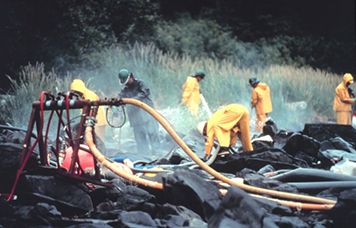How Does High-pressure, Hot-water Washing Clean up Spilled Oil?
High-pressure, hot-water washing of shorelines is often a viable method for removing stranded oil from hard surfaces, like large rocks and seawalls. However, while effective, it can directly and indirectly injure and kill plants and animals in the treated zone, both in the short-term and long-term.
When used incorrectly, high pressure water streams may drive oil into the beach sediments where oil may become trapped or further contaminate clean areas. Washing with high pressure may drive oil from the water surface down into the water column, dispersing or emulsifying the oil, which could have additional environmental effects and require additional recovery methods. In addition, using high pressure or large volumes of water can wash away fine sand and silt from shorelines and disrupt the structure of the beach.
Because of these considerations, we tend to be very cautious about the situations and habitats in which we recommend using high-pressure, hot-water washing. Slightly modifying this technique in a number of ways may remove the oil just as well while also minimizing possible injuries from response activities. For example, you can lower the water pressure, use a broad water fan or flow rather than a jet nozzle, or flush the area with warm or ambient temperature water.
Washing techniques, such as high-pressure, hot-water washing, should normally be combined with an effort to contain and collect the mobilized oil, or else it could wash up someplace else along the shoreline. The area being treated must first be contained with boom appropriate for the habitat and sea conditions.
Nearly all oils float on the water (although exceptions do exist), so the methods people use to collect the oil generally focus on removing the layer of oil from the water. How that layer is removed varies—but usually, when oil is washed off a contaminated beach, it is skimmed from the sea surface with special boats or oil skimmers. Cleanup workers also may use special sorbent booms that oil sticks to. These booms can then be collected and recycled or discarded.
Spill Containment Methods: Learn about how sensitive locations can be protected from an advancing oil slick with various kinds of equipment and tactics during an oil spill response.
Lessons Learned From the Exxon Valdez Spill: OR&R's goal is to use science to better understand physical and biological recovery after an oil spill like the Exxon Valdez, and then apply the lessons in future spill responses. This includes the use of hot-water washing on intertidal coastlines during the Exxon Valdez spill.
Has Prince William Sound Recovered From the Spill? Following the Exxon Valdez spill, the NOAA monitoring program in Prince William Sound indicated that oiled and hot-water washed sites initially suffered more severe declines in population abundance than oiled and not-washed sites.
Job Aids for Spill Response: Learn more about the job aids that OR&R has created to help oil spill responders complete their response tasks.
EPA's Oil Spill Response Techniques: The U.S. Environmental Protection Agency lists more information about response methods used during oil spills, including mechanical, chemical, and biological means.
ITOPF's Clean-Up and Response: The International Tanker Owners Pollution Federation offers detailed descriptions of the oil spill cleanup and response process, ranging from aerial observation of spills to the ultimate disposal of collected oil and oiled debris.
 An official website of the United States government.
An official website of the United States government. 
